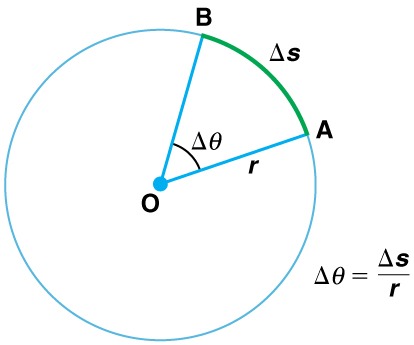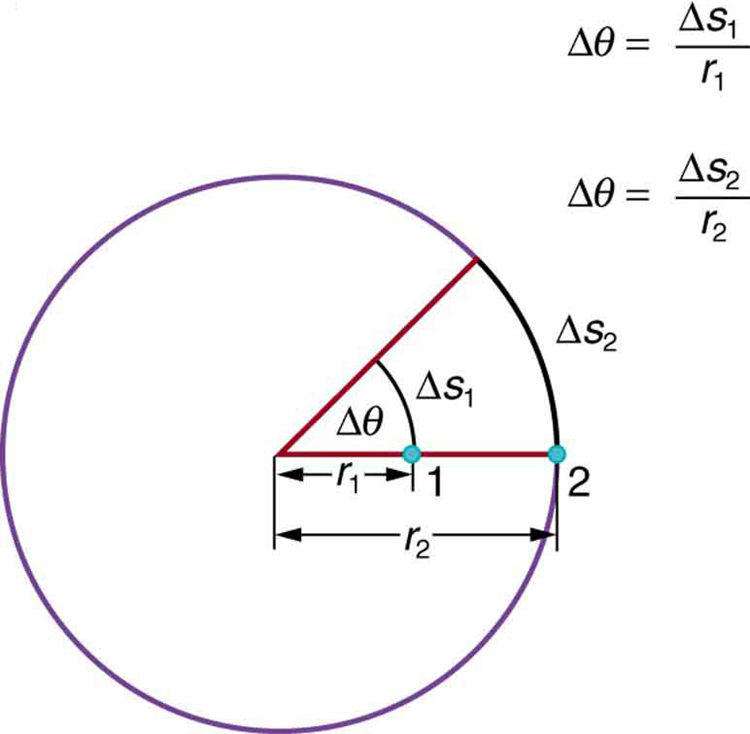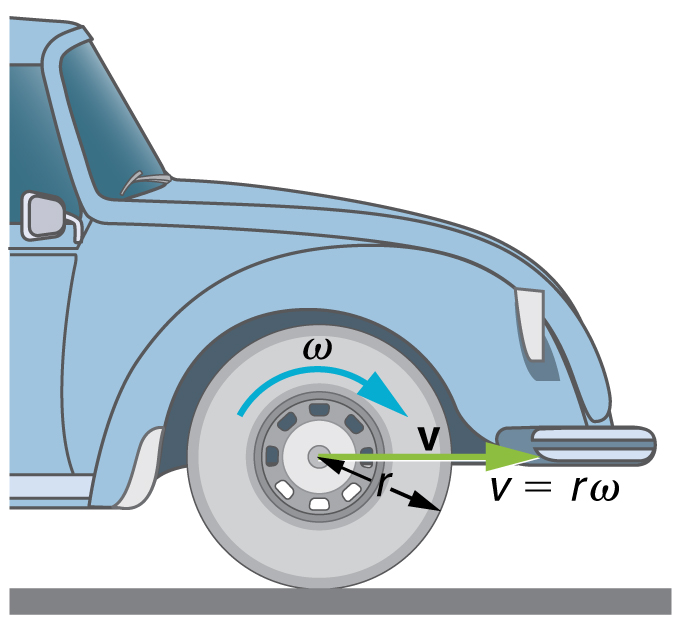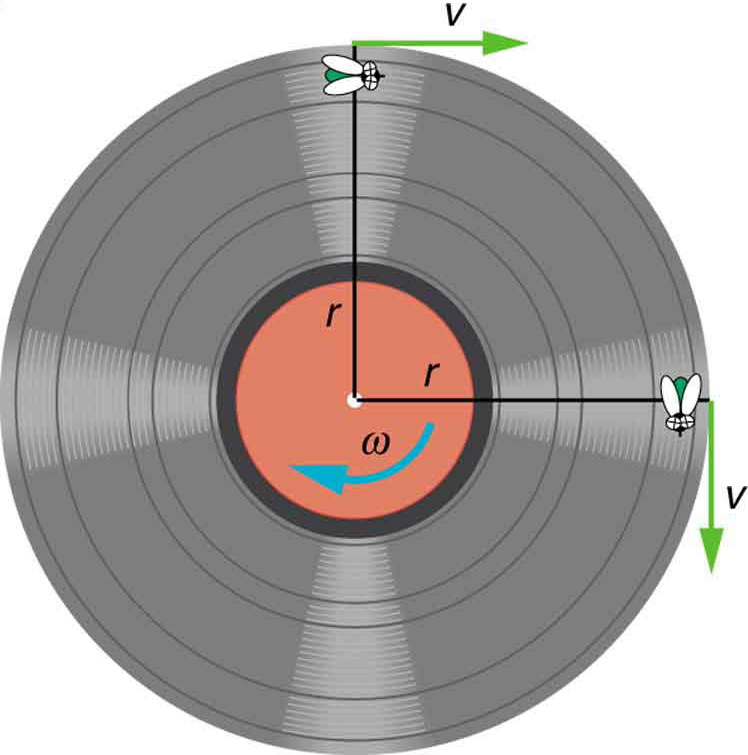Chapter 7: Angular Kinematics
7.1 Rotation Angle and Angular Velocity
Paul Peter Urone and Roger Hinrichs
Learning Objectives
By the end of this section, you will be able to:
- Define arc length, rotation angle, radius of curvature and angular velocity.
- Calculate the angular velocity of a car wheel spin.
In Chapter 2, we studied motion along a straight line and introduced such concepts as displacement, velocity, and acceleration. Chapter 3: Two-Dimensional Kinematics dealt with motion in two dimensions. Projectile motion is a special case of two-dimensional kinematics in which the object is projected into the air, while being subject to the gravitational force, and lands a distance away. In this chapter, we consider situations where the object does not land but moves in a curve. We begin the study of uniform circular motion by defining two angular quantities needed to describe rotational motion.
Rotation Angle
When objects rotate about some axis—for example, when the CD (compact disc) in the figure below rotates about its center—each point in the object follows a circular arc. Consider a line from the center of the CD to its edge. Each pit used to record sound along this line moves through the same angle in the same amount of time. The rotation angle is the amount of rotation and is analogous to linear distance. We define the rotation angle, [latex]\text{Δ}\theta[/latex], to be the ratio of the arc length to the radius of curvature:


The arc length, [latex]\text{Δs}[/latex], is the distance traveled along a circular path as shown in the figure above. Note that [latex]r[/latex] is the radius of curvature of the circular path.
We know that for one complete revolution, the arc length is the circumference of a circle of radius [latex]r[/latex]. The circumference of a circle is [latex]2\pi r[/latex]. Thus for one complete revolution the rotation angle is
This result is the basis for defining the units used to measure rotation angles, [latex]\text{Δ}\theta[/latex] to be radians(rad), defined so that
A comparison of some useful angles expressed in both degrees and radians is shown in the table below.
| Degree Measures | Radian Measure |
|---|---|
| [latex]\text{30º}[/latex] | [latex]\frac{\pi }{6}[/latex] |
| [latex]\text{60º}[/latex] | [latex]\frac{\pi }{3}[/latex] |
| [latex]\text{90º}[/latex] | [latex]\frac{\pi }{2}[/latex] |
| [latex]\text{120º}[/latex] | [latex]\frac{2\pi }{3}[/latex] |
| [latex]\text{135º}[/latex] | [latex]\frac{3\pi }{4}[/latex] |
| [latex]\text{180º}[/latex] | [latex]\pi[/latex] |

If [latex]\text{Δ}\theta =2\pi[/latex] rad, then the CD has made one complete revolution, and every point on the CD is back at its original position. Because there are [latex]\text{360º}[/latex] in a circle or one revolution, the relationship between radians and degrees is thus
so that
Angular Velocity
How fast is an object rotating? We define angular velocity, [latex]\omega[/latex], as the rate of change of an angle. In symbols, this is
where an angular rotation [latex]\text{Δ}\theta[/latex] takes place in a time [latex]\text{Δ}t[/latex]. The greater the rotation angle in a given amount of time, the greater the angular velocity. The units for angular velocity are radians per second (rad/s).
Angular velocity [latex]\omega[/latex] is analogous to linear velocity [latex]v[/latex]. To get the precise relationship between angular and linear velocity, we again consider a pit on the rotating CD. This pit moves an arc length [latex]\text{Δ}s[/latex] in a time [latex]\text{Δ}t[/latex], and so it has a linear velocity
From [latex]\text{Δ}\theta =\frac{\text{Δ}s}{r}[/latex] we see that [latex]\text{Δ}s=r\text{Δ}\theta[/latex]. Substituting this into the expression for [latex]v[/latex] gives
We write this relationship in two different ways and gain two different insights:
The first relationship in [latex]v=\mathrm{r\omega }\text{ or }\omega =\frac{v}{r}[/latex] states that the linear velocity [latex]v[/latex] is proportional to the distance from the center of rotation, thus, it is largest for a point on the rim (largest [latex]r[/latex]), as you might expect. We can also call this linear speed [latex]v[/latex] of a point on the rim the tangential speed. The second relationship in [latex]v=\mathrm{r\omega }\text{ or }\omega =\frac{v}{r}[/latex] can be illustrated by considering the tire of a moving car. Note that the speed of a point on the rim of the tire is the same as the speed [latex]v[/latex] of the car. See the figure below. So the faster the car moves, the faster the tire spins—large [latex]v[/latex] means a large [latex]\omega[/latex], because [latex]v=\mathrm{r\omega }[/latex]. Similarly, a larger-radius tire rotating at the same angular velocity ([latex]\omega[/latex]) will produce a greater linear speed ([latex]v[/latex]) for the car.

Example: How Fast Does a Car Tire Spin?
Calculate the angular velocity of a 0.300 m radius car tire when the car travels at [latex]\text{15}\text{.}0\phantom{\rule{0.25em}{0ex}}\text{m/s}[/latex] (about [latex]\text{54}\phantom{\rule{0.25em}{0ex}}\text{km/h}[/latex]).

Strategy
Because the linear speed of the tire rim is the same as the speed of the car, we have [latex]v=\text{15.0 m/s}.[/latex] The radius of the tire is given to be [latex]r=\text{0.300 m}.[/latex] Knowing [latex]v[/latex] and [latex]r[/latex], we can use the second relationship in [latex]v=\mathrm{r\omega }\mathrm{, }\omega =\frac{v}{r}[/latex] to calculate the angular velocity.
Solution
To calculate the angular velocity, we will use the following relationship:
Substituting the knowns,
Discussion
When we cancel units in the above calculation, we get 50.0/s. But the angular velocity must have units of rad/s. Because radians are actually unitless (radians are defined as a ratio of distance), we can simply insert them into the answer for the angular velocity. Also note that if an earth mover with much larger tires, say 1.20 m in radius, were moving at the same speed of 15.0 m/s, its tires would rotate more slowly. They would have an angular velocity
Both [latex]\omega[/latex] and [latex]v[/latex] have directions (hence they are angular and linear velocities, respectively). Angular velocity has only two directions with respect to the axis of rotation—it is either clockwise or counterclockwise. Linear velocity is tangent to the path, as illustrated in the figure below.
Tie an object to the end of a string and swing it around in a horizontal circle above your head (swing at your wrist). Maintain uniform speed as the object swings and measure the angular velocity of the motion. What is the approximate speed of the object? Identify a point close to your hand and take appropriate measurements to calculate the linear speed at this point. Identify other circular motions and measure their angular velocities.

Join the ladybug in an exploration of rotational motion. Rotate the merry-go-round to change its angle, or choose a constant angular velocity or angular acceleration. Explore how circular motion relates to the bug’s x,y position, velocity, and acceleration using vectors or graphs.

